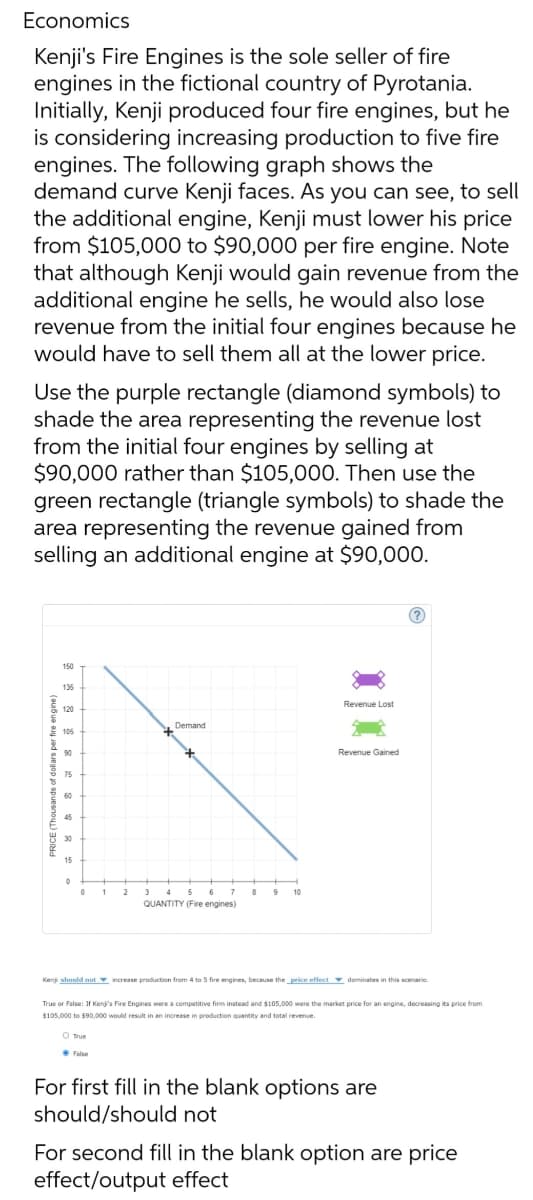es in the fictional country of Pyrotar ly, Kenji produced four fire engines, sidering increasing production to fi es. The following graph shows the nd curve Kenji faces. As you can see dditional engine, Kenji must lower hi $105,000 to $90,000 per fire engine Ithough Kenji would gain revenue fr onal engine he sells, he would also ue from the initial four engines beca d have to sell them all at the lower p be purple rectangle (diamond symb
es in the fictional country of Pyrotar ly, Kenji produced four fire engines, sidering increasing production to fi es. The following graph shows the nd curve Kenji faces. As you can see dditional engine, Kenji must lower hi $105,000 to $90,000 per fire engine Ithough Kenji would gain revenue fr onal engine he sells, he would also ue from the initial four engines beca d have to sell them all at the lower p be purple rectangle (diamond symb
Economics (MindTap Course List)
13th Edition
ISBN:9781337617383
Author:Roger A. Arnold
Publisher:Roger A. Arnold
Chapter30: Market Failure: Externalities, Public Goods, And Asymmetric Information
Section30.2: Internalizing Externalities
Problem 2ST
Related questions
Question
1

Transcribed Image Text:Economics
Kenji's Fire Engines is the sole seller of fire
engines in the fictional country of Pyrotania.
Initially, Kenji produced four fire engines, but he
is considering increasing production to five fire
engines. The following graph shows the
demand curve Kenji faces. As you can see, to sell
the additional engine, Kenji must lower his price
from $105,000 to $90,000 per fire engine. Note
that although Kenji would gain revenue from the
additional engine he sells, he would also lose
revenue from the initial four engines because he
would have to sell them all at the lower price.
Use the purple rectangle (diamond symbols) to
shade the area representing the revenue lost
from the initial four engines by selling at
$90,000 rather than $105,000. Then use the
green rectangle (triangle symbols) to shade the
area representing the revenue gained from
selling an additional engine at $90,000.
150
136
105
90
Demand
X
False
QUANTITY (Fire engines)
Revenue Lost
Revenue Gained
Kenji should not increase production from 4 to 5 fire engines, because the price effect dominates in this scenario.
True or False: If Kenji's Fire Engines were a competitive firm instead and $105,000 were the market price for an engine, decreasing its price from
$105,000 to $90,000 would result in an increase in production quantity and total revenue.
For first fill in the blank options are
should/should not
For second fill in the blank option are price
effect/output effect
Expert Solution
This question has been solved!
Explore an expertly crafted, step-by-step solution for a thorough understanding of key concepts.
Step by step
Solved in 2 steps with 1 images

Knowledge Booster
Learn more about
Need a deep-dive on the concept behind this application? Look no further. Learn more about this topic, economics and related others by exploring similar questions and additional content below.Recommended textbooks for you

Economics (MindTap Course List)
Economics
ISBN:
9781337617383
Author:
Roger A. Arnold
Publisher:
Cengage Learning


Economics (MindTap Course List)
Economics
ISBN:
9781337617383
Author:
Roger A. Arnold
Publisher:
Cengage Learning
